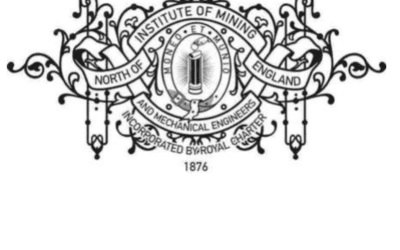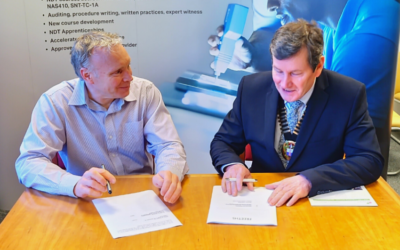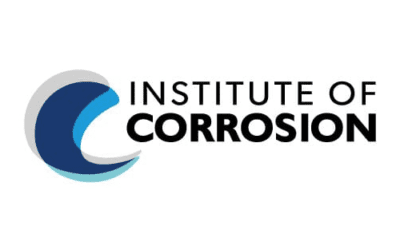For the 2020-21 session, the branch is pleased to welcome Dr Muhammad Ejaz PhD, CEng FICorr, FIMMM as its new Chair, together with a very strong and diverse branch committee, whose details can be found at, https://www.icorr.org/aberdeen/
Aberdeen started its new session on 24 September with record attendance of 311 for its annual joint ICorr/TWI event with a webinar on “High Tensile Steel Bolts and Nuts – Hydrogen Embrittlement and Failure in Corrosive Environments” with speaker Alan Denney of AKD Materials Consulting Ltd. This very well-presented talk took a topical view of the long-standing issue of hydrogen embrittlement of high tensile fasteners, and the dramatic failures which can occur as a consequence. Alan started with the threaded components used as shear connectors for the earthquake resistance on the San Francisco Oakland Bay Bridge, and the causes of these failures. The talk then referred back to the historical problems with high tensile bolts caused by hydrogen embrittlement due to manufacture, and recent problems with high tensile bolts in building structures in London. To close the talk Alan brought us up to date with the modern offshore environment with issues due to environmental corrosion in offshore wind turbine structures, and work in Germany to define and limit the conditions for its occurrence, and potential prevention or mitigation measures.
Following on from its well-received April/July events, ICorr Aberdeen /MCF jointly ran a new series of ‘Lunch and Learns’ between 5 and 9 October. Opening the week was a fascinating talk by Simon J. Sparke – International Well Integrity Ltd, on the “History of well integrity and its business impacts to the Oil and Gas industry”. Graham Greenwood Sole – Corrocoat, then described their advanced glass flake technologies and S/T aerosol type solutions for marine corrosion protection. Gary Whyman – Emerson Automation, followed with the question, “What is proactive maintenance, and how does it differ from preventive and predictive maintenance? Moving onto Renewables, Neil Gallon – Rosen UK, considered Integrity management of hydrogen transportation pipelines and to close the week, Svenn Magne Wigen – Force Technology Norway, discussed subsea survey utilisation of highly sensitive field gradient sensors for optimisation of CP life extension.
On 15 October, the branch welcomed Oceaneering for a ‘virtual’ Industrial visit, hosted by Ian Drummond (Regional Business Development Manager – Europe & Africa) on the theme, “Integrity Management and Digital Solutions: Fly, Swim or Crawl?”
Oceaneering is a global provider of engineered services and products, primarily to the offshore energy industry. From remote inspection to capturing and managing data more effectively, Oceaneering offers a range of integrity solutions that optimise inspection and maintenance regimes to deliver significant time and cost savings.
SME technical presentations of three key business areas, with the focus on techniques to identify and predict external corrosion, were given together with simulations of these technologies.
Lisa McCrory – Product Manager – Integrity, presented Inform InspectTM
Inform InspectTM is an intuitive and flexible digital asset inspection tool that enables users to plan, schedule, execute and review inspection work scopes in real time, significantly reducing end to end inspection times. It allows international co-operation between technicians and subject matter experts. It is cloud based tool that allows remote working using tablets at site, through which the technician can execute the inspection and send back the work pack for review and report generation. Targeted rejection is sent back to the technician and as threshold alerts are also in the system, notification is given that results have crossed over pre-set alarm levels such as MAWT (min. allowable wall thickness for piping or vessel) or NOM. (nominal value of material schedule). They can choose whether to accept or reject the results or send back for review. All data is stored in a secure global portal and the system also has built in training modules through the web portal. Inform InspectTM is field proven and connects seamlessly with integrity and maintenance management systems to deliver credible up to date inspection data. Multi-method inspections of visual, electromagnetic, ultrasonic and radiographic can all be managed through questionnaire templates that are customised through client / project input.
Jim McNab – Non-Destructive Testing SME, presented the Trip Avoidance X-Ray Inspection System (TAXI™)
It’s fair to say, the industry as a whole respects conventional radiography as a trusted, very reliable, easily interpreted method with a high PoD even for the smallest flaws like corrosion pits, however, it’s associated with safety issues, it’s time consuming, disruptive and has a limited deliverable format i.e. a single conventional film only a few people get to see.
TAXI™ has managed to largely address all of these ‘negatives’ especially for CUI, where the majority of leaks occur in smaller than 4” OD pipes, with the added bonus of having very limited effects on nucleonic level control instrumentation.
Pressure plant equipment sometimes has nucleonic level control instrumentation which monitors the fluid levels in vessels. Gamma rays from a normal source used in NDT on pipes is sensed by the nucleonics. The separator misinterprets the signal thinking the vessel has evacuated its fluids inventory. To avoid these ‘false alarms’, conventional radiography is carried out by temporarily isolating the equipment, running the plant ‘blind’ risking unmonitored process operational issues, or deferring to plant shutdown to allow liquidation of radiography workscopes.
For the UK continental shelf, data shows that plant failure and unplanned shutdowns account for nearly 20% of production losses, approx. 100 million barrels of oil equivalent in 2019.
TAXI™ delivers pulsed X-radiation, which has little effect on nucleonic instrumentation while giving high quality digital x-ray images in 8 seconds. 20-25 exposures can be performed per shift, up to 4 times more than standard radiation techniques – allowing uninterrupted operation and production. Control room liaison is still critical, but there has been new confidence with this system. It uses digital detection media which absorb radiation quicker (compared to conventional film) and has a larger exposure latitude/dynamic range. There is therefore no need to use multiple exposure on thicker pipes, or on pipes filled with denser liquids and sediment. Extensive verification testing of the system was carried out to ensure it worked in a range of conditions and settings.
Digital radiographs demonstrating exposure latitude/dynamic range of the system were shown of thick wall double insulated pipe filled with fluid and internal sediment, clearly visible. A badly corroded pipe with external corrosion scab radiograph revealed unexpectedly that cracks were in the scab rather than the pipe wall. X-rays of Swagelok™ fittings had such detail that small faults could be determined in the assembly of fittings to the pipes.
Other key benefits of the system were the small area of radiation used, the reduced radiation exposure time, and use of no radioactive materials which require ‘dangerous goods’ classification.
Finally, Iain Jarvie – Senior Consultant Engineer, presented the Vibration Induced Fatigue Digital Twin technology.
According to UK HSE data, from 1998 to 2015 there were 303 fatigue related hydrocarbon releases in the UK sector, of which 125 could have led to a major incident. Could these have been prevented?
Vibration and the resulting stress cycles, due to fluid flow, can cause fatigue cracks. The cyclic stress amplitudes that can cause a crack can be more than 10 times lower than the yield stress of the material. These cracks propagate through the material leading to loss of containment and hydrocarbon release.
The Energy Institute ‘Guidelines for the avoidance of vibration induced fatigue in process pipework’ are used throughout industry to manage this problem. The method relies on a risk based approach with regular visits to the plant by specialist engineers. The guidelines have reduced the number of failures, however HSE data shows that vibration induced fatigue is still a significant problem for the oil and gas industry.
Oceaneering have developed new ways to tackle this problem, including:
- A vibration measurement tablet that can be used by operator personnel, which automatically uploads data to the cloud for onshore assessment;
- A helmet camera system that provides a live 2-way audio and video feed from the asset, allowing operator personnel to assess a problem with onshore specialist support; and
- Pipework Digital twin Technology
The digital twin is fed by live sensor data and uses a library of pre-solved model solutions to find the best fitting representation of the pipework. Machine learning algorithms are then used to interrogate live measurement data and extract the force spectra acting on the pipework, allowing a real time fatigue damage assessment and real time root cause analysis. This technology has been used extensively in the aircraft industry. Its application in oil and gas has the potential to reduce or eliminate vibration related fatigue failures. Corrosion can reduce fatigue strength by 35%, the digital twin technology allows this effect to be included and quantified. The live remote monitoring and fatigue assessment provided by the digital twin reduces/eliminates the need for engineer visits, with issues being identified and mitigated using onshore resources.
An extensive Q&A Session chaired by Ian Drummond closed this very successful Event.
The full recording of this event is available for viewing at: https://www.oceaneering.com/tradeshows/icorr-a-virtual-industrial-visit/
Aberdeen Branch maintain an extensive database of past presentations covering all areas of corrosion management. Copies of these can be found at: https://www.icorr.org/aberdeen/ and a photo gallery at: https://sites.google.com/site/icorrabz/event-gallery. The branch also has a new You Tube channel at: https://www.youtube.com/channel/UCNW-HoZVEMA79-4Y6k5E0ow/featured
Full details of upcoming events may be found on the main ICorr Website https://www.icorr.org/events/list/ or by contacting: ICorrABZ@gmail.com



